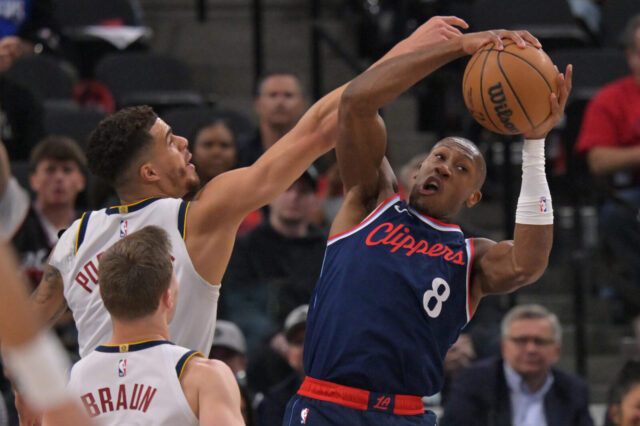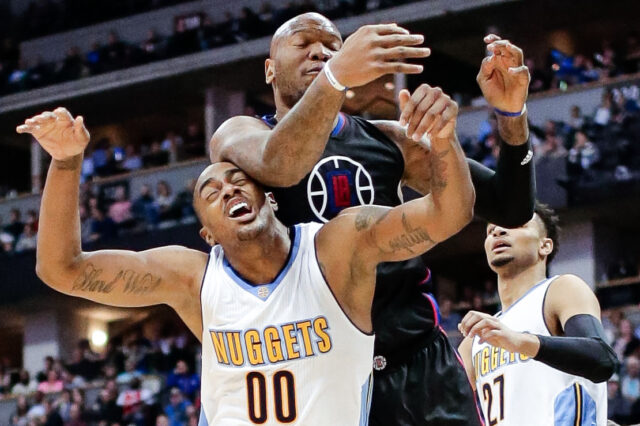Join me in my four-part series leading up to the showdown over the new collective bargaining agreement in the National Basketball Association between the owners and the players. In this part we will explore how we got to this point.
Please read: This summary is in no way comprehensive. I'm trying to break down the labor dispute and put it into layman terms as much as I can. However, I have provided many links. I encourage everyone to read them. This is an important issue.
It's a vexing question really. How did we get to this point? How did the NBA and its players get to the point where the owners are threatening to lock players out, and the players are threatening to decertify their union? Well, let's take a look at events that transpired.
Collective Bargaining defined:
Down to it's essence, Collective Bargaining is the process in which an employer and employee enter into an agreement on contractual work, ie: bargaining. The collective part comes from the workers banding together as one entity to act as a single bargaining unit so everyone is represented uniformly. The 1935 Labor Relations Act gives the right to employees (union) to collectively bargain with employers under rules applied by the U.S. government.
When a contract expires, a new one is needed. The employer requests meetings with union leaders to negotiate a new set of conditions to cover for a brand-new contract. It doesn't always go smoothly, and sometimes you have a strike (withholding of work by the employees) or a lockout (a denial of work entry by the employer). Often times, a union or even an employer will use what is called an arbitrator or a third-party judge to settle the dispute.
1999 – Players get locked out and eventually sign a new CBA:
David Stern and the NBA owners locked out the players during the 1998-99 season. The goal is to reduce player salaries and to go after the sacred Larry Bird Exception (which allows a team which has had a player for three-plus seasons to pay the the maximum amount of money to re-sign that player) . The Players balked and said they wanted a higher rookie pay scale and to maintain max salaries, while retaining their 57% of "money spent on players" revenue (which is different from dividing profits) . Clearly at an impasse, David Stern and the owners locked the players out. A work stoppage of 191 days occurred.
Once the lockout was over (mostly due to player divisions within the NBA Players Association) the players were forced to accept capped "Maximum salaries" at $9 million and $14 million (with the max only achievable after 10 years). An even more stringent rookie pay scale was put into place, based on where players were selected in the NBA Draft, i.e. the No. 1 overall pick vs. the No. 21st overall pick (although, the rookie minimum salary was raised). The players retained the Bird Exception and added two new ones, the so-called Mid-Level Exception (MLE) and Bi-Annual Exception (BAE), initially called Median, and Average Exception, which allowed a team to exceed the salary cap by using the designated exception. Also introduced was the Luxury Tax, a threshold which was an idea initially floated in the 1995 CBA. The players also retained their 57% of "money spent on players" revenue.
A 50 game schedule was eventually played in the ’98-99 season, and the San Antonio Spurs defeated the New York Knicks behind young Tim Duncan. An intense “good guy” marketing scheme is put out by the NBA emphasizing Tim Duncan (even though the Lakers win the next three championships) in order to counter the ill will created by the lockout in an attempt to win back the casual NBA fans.
2005 – New Agreement ratified:
This is essentially the same agreement as the 1999 CBA. However, this time teams were allowed to know the Luxury tax threshold before the season started (before, a luxury tax penalty would be added after the season once calculated against team revenues). The MLE was raised to $5 million per season to spend on players. Maybe most importantly, the NBA raised the minimum age to enter the NBA draft to 19 years-old. Thus essentially creating the one-and-done of high school players being forced to attend at least one-year in college or go overseas until their 19th birthday. For a thorough description of the 2005 CBA please follow this link: Here.
2010 – Owners complaints/proposal:
The NBA owners have been, basically, openly complaining that players have been receiving more than their fair share of value added escrow revenue at 57% since 1999. It seems this time they want to seriously go after player salaries. A reduction of 38% has been proposed for max salaries and a 20% cut in the rookie pay scale. As well as a hard salary cap. Also the owners are seeking to (again) limit the amount of exceptions to circumvent the salary cap (Bird exception, MLE, BAE) while maintaining the trade exceptions. The owners also would like to limit the guarantees for player salaries to less than 50% of actual value (similar to the NFL) and some owners have even floated the idea of "Franchise Player" tag which keeps a player on his current team for one year at the max average salary for his position with guaranteed money. The NBA also claims it lost $400 million and that is the basis for the reduction in the players' salaries proposals. The owners have not altered their position since this proposal was made last year.
It is also proposed that the league restrict player movement to avoid the mass exodus of top talent from smaller market teams to large market teams (like the NFL). It is speculated that adopting the previously mentioned "Franchise tag" that the NFL uses will be sufficient. Other owners are not convinced this is the best thing for the NBA. There's no unified front on this issue.
2010 – Players complaints/proposal:
To counter the owners proposal, the players have (seemingly for the first time) decided to negotiate the 57% revenue threshold on a sliding scale to lessen the burden payed out of escrow if the league exceeds it's margin. This has never been offered by the NBAPA before. While the union disputes the $400 million loss the NBA reported, (the NBA has not yet turned over it's books to an arbitrator or to the Union) it was deemed important by the players to concede this point. To counter losses the players proposed two year slide in "negotiated salaries" (a reduction in player salary at the CBA level for a set two year period) as well as the elimination of the BAE to be replaced by another MLE at a reduced maximum threshold (less than the $5 million maximum negotiated in 2005).
The players also proposed loosening trade restrictions which they view as revenue-neutral and to raise the Base Compensation Threshold (the number you must match for a trade to go through) from 125% to 250% … which in the union's view would make it easier to unload bad contracts. Also the union proposed loosening the time a team has to match the offer on a restricted free agent, that time period has been seven days to match on restricted free agent.
Non "revenue" proposals also include reducing the age restriction from 19 years-old back to 18 years-old, and increasing the pension of retired players by assessing a penalty to owners who sell their team at a windfall profit.
Overview:
The players and owners haven't actually met in person since the All Star game in Dallas last season. That was February.. This doesn't bode well for the chances of avoiding a labor showdown. The owners, very clearly, want to alter player salaries in dramatic fashion and are prepared to lock the players out in order to accomplish that goal. The players, interestingly enough, compromised on the very thing the owners have been complaining about for 11 years (the 57% escrow revenue spent on players), but that didn't meet the owners demands.
In going after guaranteed contracts, the owners (in the players view) are asking the players to protect them from themselves. With billions of dollars in TV contracts, you would think that the owners would be bathing in Dead Presidents and lighting their cigars with 100 dollar bills. Not so, according to the owners. The owners believe getting a pay structure similar to that of the NFL and NHL would benefit the NBA game, while selling the public that these procedures will help competitive balance in the NBA and allow small and medium (Denver would qualify as medium) market teams to compete with the big boys in New York, Los Angeles and a couple other big cities.
While player movement such as we saw this summer is an issue, both sides agree that what happened in Miami this past off-season ramped up interest and in a backhanded way benefited the League. The small and medium sized market owners want player movement restricted, while the large market owners seem to be ambivalent at best towards it.
There is one part of the NBA's troubles that isn't spoken about as frequently. In part two we will discuss the NBA's second issue. The revenue sharing problem that allows owners such as Jerry Buss and Mark Cuban to print their own money. It is here where the owners are fighting amongst themselves … and the fight could get even more bloody than the dispute with the players. Who's playing the lead in this drama of the billionaires?
The Nuggets own E. Stanley Kroenke.


